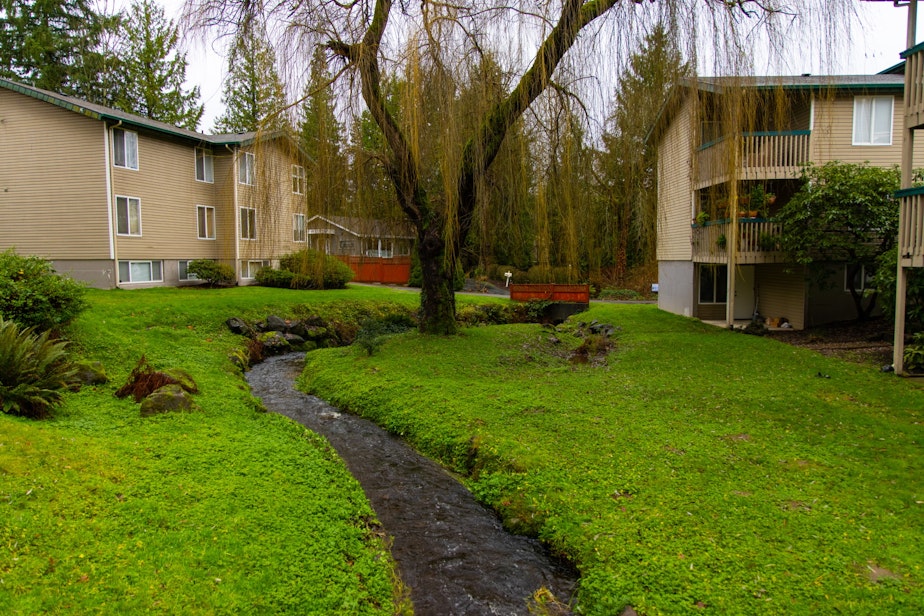Why experts say Amazon’s fund for Seattle-area affordable housing is huge, but not nearly enough

This week Amazon pledged $2 billion for affordable housing. It’ll be spent around cities where Amazon has large headquarters, including the Seattle area; Arlington, Virginia; and Nashville, Tennessee.
But experts say it’s not nearly enough to resolve the Seattle metro region's housing shortage.
Make no mistake: This is a big gift to the region.
It's big even if only a third of the money ends up being spent on housing in the greater Seattle area.
This is not housing for Amazon employees. It’s targeted for people who do not make tech salaries.
There are two ways you can spend money on affordable housing:
- You can build a shiny new apartment building.
- Or you can preserve existing affordable housing by buying it and taking it off the market before it gets flipped or torn down and turned into something else.
Sponsored
“Every day, affordability is being lost to the market,” says Susan Boyd, of Bellwether housing.
Sponsored
She says Amazon is taking this second approach: Saving the old stuff.
Boyd says this is wise, unsexy work, because it’s cheaper to save old housing than build new housing, at least if you’re outside Seattle’s city limits.
"What people hear is, 'We have a severe housing crisis, we don't have enough units, " says Michael Brown of the Seattle Foundation. "What needs to be married to that is, 'We have a severe housing crisis, we don't have enough units, and we're losing a lot of units."
Stephen Norman runs the King County Housing Authority, an organization that stands to benefit the most from this. He said much of the money from the first wave of Amazon's spending will be spent on the east side of Lake Washington, where there are still pockets of affordable housing left to preserve.
“This is an area where we’re seeing the remaining naturally affordable housing rapidly diminishing,” he said “And I think we have a very limited window to preserve what’s left.”
Sponsored
That becomes even more urgent with Amazon hiring 25,000 people in Bellevue in the next four years.
Claudia Balducci represents East King County on the County Council. She says this is really important because “if you look at the income levels and the cost to live here – we are rapidly evolving from an expensive community – into an exclusive community.”
How much affordable housing will this actually preserve?
It’ll save housing for about a thousand local families in the first year. It’s not actually housing a thousand new families, it’s keeping a thousand families in homes they can afford.
This is housing for people like nurses, plumbers, teachers and bus drivers. And with their housing saved, they won’t have to move further away and commute longer.
Sponsored
At the same time, Amazon will be making other investments in housing near its offices in other cities.
Sponsored
By 2025, this money could save housing for maybe 6,000 or 7,000 local families, depending on how Amazon divides the money between Seattle, Arlington, and Nashville.
But a recent study showed that the Puget Sound region has lost a net total of 112,000 affordable homes in the last decade. So, you can see how far this money is from solving the region’s housing shortage.
This is an $18 billion problem in this region, according to Claudia Balducci, and Amazon and Microsoft together have pledged, according to a little back of the napkin math, about 8% of that money. Microsoft’s pledge came back in 2019.
“This is such a big problem – and it’s such a giant challenge – this is not one of these things that government can solve alone, that one or two companies can solve alone, or that the development community can solve alone,” s aid Josh Brown, head of the Puget Sound Regional Council. “We all need to contribute to the solution.”
Building enough affordable housing in this region – is like trying to fill a bucket. Amazon is helping plug a hole in a bucket, by preserving a fraction of the affordable housing we have. Affordable housing builders like Bellwether and Plymouth are adding water to the bucket – one small cupful at a time.
Sponsored
Josh Brown says there’s a way to fill the bucket much faster – by turning on the hose. Single family zoning currently keeps much of the region’s land out of circulation.
Brown says if we opened it up to denser development, allowing more townhouses and small apartment buildings, that would be like turning on the hose. It would also relieve financial pressure on the affordable housing we still have – and make it less expensive to preserve.
That would help Amazon’s money go farther.
You can reach reporter Joshua McNichols at jmcnichols@kuow.org.

